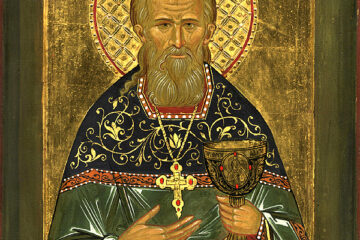But some men came down from Judea and were teaching the brethren, “Unless you are circumcised according to the custom of Moses, you cannot be saved.” And when Paul and Barnabas had no small dissension and debate with them, Paul and Barnabas and some of the others were appointed to go up to Jerusalem to the apostles and the elders about this question. So, being sent on their way by the church, they passed through both Phoeni′cia and Samar′ia, reporting the conversion of the Gentiles, and they gave great joy to all the brethren. When they came to Jerusalem, they were welcomed by the church and the apostles and the elders, and they declared all that God had done with them. But some believers who belonged to the party of the Pharisees rose up, and said, “It is necessary to circumcise them, and to charge them to keep the law of Moses.”
The apostles and the elders were gathered together to consider this matter. And after there had been much debate, Peter rose and said to them, “Brethren, you know that in the early days God made choice among you, that by my mouth the Gentiles should hear the word of the gospel and believe. And God who knows the heart bore witness to them, giving them the Holy Spirit just as he did to us; and he made no distinction between us and them, but cleansed their hearts by faith. Now therefore why do you make trial of God by putting a yoke upon the neck of the disciples which neither our fathers nor we have been able to bear? But we believe that we shall be saved through the grace of the Lord Jesus, just as they will.”
Acts 15:1-11
Christ is Risen!
Thank you to the Prayer Team members who contributed to our Arise & Build Capital Campaign at St. John last month. This evening, Wednesday, April 30, at 6:00 p.m. (EST), we will offer a Paraklesis Service, and remember in prayer all those who contributed to this program. In our parish, we have invited each participant to be remembered in prayer in our church, so that as they offer something of their sustenance, we are praying that they will always have sustenance. The Paraklesis is being offered so that we can remember in prayer all those who are not living in the Tampa Bay area who contributed to this project. You can participate via livestream by going to https://stjohntpa.org/live/
The idea of an Ecumenical Council has its roots in Acts 15, with the Council at Jerusalem. The first major dispute in the early church had to do with circumcision. Anyone who was Jewish needed to be circumcised. Jesus came as the “King of the Jews” and to redeem His chosen people. The term “Gentile” refers to the non-Jews. Christ’s message of salvation was for Jews and Gentiles. As Gentiles entered into Christianity, there was a dispute about whether they must follow the Law of Moses before following the Law of Christ, in other words, that anyone converting to Christianity but be circumcised. A Council took place in Jerusalem, let by Paul and Barnabas, which concluded that circumcision was not a necessary pre-requisite to becoming a Christian, which remains the case to this day. (It is not wrong for a Christian to be circumcised, there are medical/health reasons to do that. It is not done for religious reasons.) There were people on both sides of the issue and not everyone was convinced this was the right decision. There were people who opposed Paul and Barnabas for the rest of their lives. What this Council at Jerusalem did, however, was to set up the idea that problems in the Church are solved in a conciliar way, in other words, by council, not by decree of one person.
For its first nearly three hundred years, the Church was persecuted by the Romans. There were not big public displays of worship, no opulent churches, no freedom to worship. Christianity was practiced in secret. Tradition holds that the “sign of the fish” was a secret sign Christians used in order to gain admittance to gatherings for worship. The only time the church came out in public was when a Christian was caught and executed for their Christianity. Devout Christians made public exclamations of faith, under threat of death, and often were put to death because of their public proclamation, which was sometimes done in front of the Emperor, defying his order to renounce Christ. Ironically, the Church, during this period of persecution, grew by about 40% per decade. People saw the witness of Christians so committed to their faith that they were willing to be tortured and killed for it and this was a compounding reason to believe that Someone people were willing to die for was worthy to be followed.
Putting ourselves back into history, communication was not anything like it is now. It was a big effort to journey even one hundred miles back then. People stuck to their hometowns, and information was disseminated slowly and often inaccurately. In the world of the early church, there wasn’t unity of belief or practice. The Church of Jerusalem was practicing slightly differently than the Church of Rome, or the Church of Antioch, etc.
The Emperor Constantine, through the Edict of Milan in 313 A.D. made Christianity the legal religion of the Roman Empire. Now Christians came out from the catacombs and into the public. And as information emerged about how various Churches were believing and practicing, it became apparent that there wasn’t a unity of belief or practice and that certain heretical teachings were being promulgated.
The Emperor Constantine, recognizing that Rome was in severe decline, both economically and militarily, decided to move what was then the capital of the world, and the see of the Roman Empire, from Rome to what is present-day Istanbul, Turkey. The city at the time was called “Byzantium.” The city was rebuilt and eventually named Constantinople. Thus ended the Roman Empire and began the Byzantine Empire, which lasted from 325 A.D. until its collapse in 1453 A.D.
While Byzantium was being rebuilt, Constantine set up his interim capital in Nicomedia. And nearby Nicomedia was the city of Nicaea. Constantine desired to gather all the bishops of the world together for an “Ecumenical Council” to unify belief and practice in a church that was divided by heresies. Nicaea was chosen because of its proximity to Nicomedia, so that Constantine could be an active participant.
The Ecumenical Council of Nicaea (325) was the first of Seven Ecumenical Councils. The other Ecumenical Councils were Constantinople (381), Ephesus (431), Chalcedon (451), Constantinople (553), Constantinople (68-681) and Nicaea (787). Each one was called as a result of heresy or question within the Church over belief or practice. Each one resulted in the writing of “canons” that make up the bulk of our theology and practice. There is a book of the canons, called “The Rudder” which contains the canons adopted at each Ecumenical Council. Canon law is the study and implementation of the canons. The Rudder reads like a law book, and is consulted now to aid in helping the church stay unified and avoiding heresy. A Council is considered an Ecumenical Council because every church—Diocese, Metropolis, Archdiocese, etc.—is represented. There were 318 bishop who participated in the first Ecumenical Council, representing the various established churches of the time. Because of the Great Schism in 1054 A.D., which separates the Church of Rome (Roman Catholic) from the Church of Constantinople (Eastern Orthodox) and the subsequent fracturing of the West because of the Protestant Reformation in 1517 A.D. (which continues fracturing to this day), there cannot be an “ecumenical council.” Back in 325 A.D., there was just one church, so there could be “ecumenical” (meaning universal) participation from every church locality.
The immediate reason for the First Ecumenical Council had to do with the heresy or Arianism, a doctrine that was being advanced by a bishop named Arias, who contended that Jesus Christ was a created being and therefore not truly the one God. We will discuss the outcome of the First Ecumenical Council in the next reflection, as it set in motion three things that are central to our faith and it’s practice.
Lord, thank You for the Divine Wisdom that You have always put into the minds and hearts of those called to lead our Church. In times of controversy, we have always found ways to preserve and project our faith. Thank You for providing leaders in every generation who have been committed to preserving the way, the truth and the life that are identity of Jesus Christ and the path to the Kingdom of Heaven. Amen.
St. Athanasios the Great, St. Nicholas of Myra, St. Spyridon of Trimythous, St. Alexander of Alexandria, and St. Paphnutius of Egypt were all saints that took part in the First Ecumenical Council of Nicaea in 325 A.D.



0 Comments